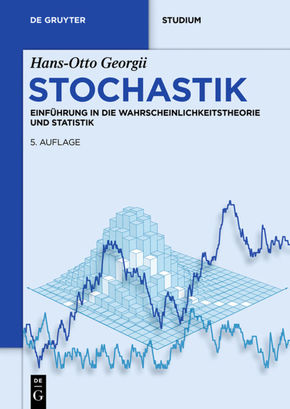Stochastik - Einführung in die Wahrscheinlichkeitstheorie und Statistik
| Verlag | De Gruyter |
| Auflage | 2015 |
| Seiten | 438 |
| Format | 17,0 x 24,0 x 2,2 cm |
| Großformatiges Paperback. Klappenbroschur | |
| Gewicht | 755 g |
| Reihe | De Gruyter Studium |
| ISBN-10 | 3110359693 |
| ISBN-13 | 9783110359695 |
| Bestell-Nr | 11035969A |
Dieses Lehrbuch gibt eine Einführung in die "Mathematik des Zufalls", bestehend aus den beiden Teilbereichen Wahrscheinlichkeitstheorie und Statistik. Die stochastischen Konzepte, Modelle und Methoden werden durch typische Anwendungsbeispiele motiviert und anschließend systematisch entwickelt. Der dafür notwendige maßtheoretische Rahmen wird gleich zu Beginn auf elementarem Niveau bereitgestellt. Zahlreiche Übungsaufgaben, zum Teil mit Lösungsskizzen, illustrieren und ergänzen den Text. Zielgruppe sind Studierende der Mathematik ab dem dritten Semester, sowie Naturwissenschaftler und Informatiker mit Interesse an den mathematischen Grundlagen der Stochastik.
Die 5. Auflage wurde nochmals bearbeitet und maßvoll ergänzt.
Inhaltsverzeichnis:
Wahrscheinlichkeitstheorie
Mathematische Beschreibung von Zufallssituationen Stochastische Standardmodelle Bedingte Wahrscheinlichkeiten und Unabhängigkeit Erwartungswert und Varianz Gesetz der großen Zahl und zentraler Grenzwertsatz Markov-Ketten
Statistik
Parameterschätzung Konfidenzbereiche Rund um die Normalverteilung Testen von Hypothesen Asymptotische Tests und Rangtests Regressions- und Varianzanalyse
Rezension:
Review for the 3rd edition by Vladimir P. Kurenok (MathSciNet)
"The 3rd edition of the book has been further extended and improved. The textbook is based on a series of lectures taught by the author for many years at the Mathematical Institute of the University of Munich. The material of the book covers two one-semester courses in probability and mathematical statistics, respectively. All chapters are equipped with exercises of varying degrees of difficulty that help to clarify the concepts.
The first part of the book is an introduction to probability theory. The material is presented using little of the measure-theoretical background but rather application-oriented examples that preserve its introductory character. Topics range from classical probability distributions to conditional distributions and limit theorems. A short introduction to Markov chains is also given. The second part of the book gives an introduction to mathematical statistics and describes ma in statistical procedures: parameter and interval estimation, hypothesis testing, linear regression and basics of the analysis of variance approach.
The book can be used by undergraduate mathematics majors but also by science and engineering students who wish not only to apply probability and statistics but also to understand how the methods work."

